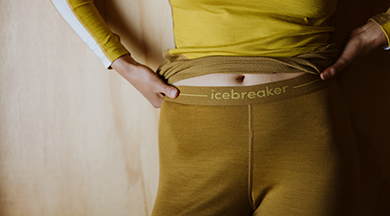Why icebreaker merino wool?
Hand picked - quality control of our fiber
icebreaker merino criteria
Fibre length
We specify maximum and minimum fibre length. This has been customised according to the yarns and products icebreaker produce.
Fibre strength
Fibre must be strong. Weak fibre will break during processing and wear, and can cause fabric flaws.
Micron
We specify a maximum and minimum fibre diameter to ensure hand feel and softness.
Coefficient of variation
We also specify the maximum variation in fibre diameter to ensure hand feel and softness.
Color
Wool must be very white, with no colour flaws as this would impact on the ability to achieve icebreaker’s colour palette.
Vegetable matter
VM can be a problem in processing and can also lead to contamination and issues with fabric and color flaws. We specify a maximum VM content (very low).
Dark fibres
Dark fibres naturally occur in sheep, but can result in colour and fabric flaws. icebreaker specifies very low dark fibre contamination.
Wool style
It must be the icebreaker ‘style’ of wool. This relates to crimp and the overall structure of the fleece and fibre, and has been customised to the yarns and products we create.
Absence of flaws
Wool can have all sorts of other flaws, so growers are always on the lookout to remove anything that will impact icebreaker product quality.
The five freedoms of the lambs
Guaranteeing the five key freedoms for our flocks means you can feel happy in the knowledge that the sheep felt just as good making your icebreaker merino as you will wearing it!
01
Never hungry
or thirsty
Growers ensure that their sheep always have access to clean water and adequate nutrition.
02
Where sheep
can be sheep
Sheep are free to roam in open pastures, so they can behave naturally with minimal human intervention.
03
A place
to call home
Growers ensure that their sheep have adequate shade and shelter at all times.
04
Out of
harm’s way
Growers are required to regularly monitor stock, make sure their sheep never experience unnecessary stress or pain, prevent disease and illness, and rapidly diagnose health issues.
05
Stress-free sheep
Growers must handle sheep in a way that avoids unnecessary stress and pain. The practice of mulesing is not permitted.










